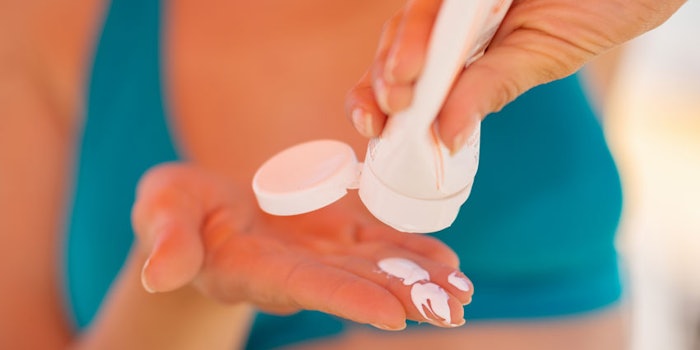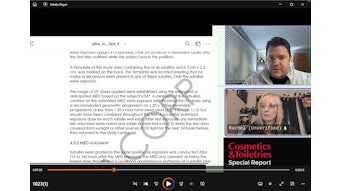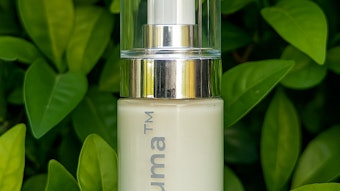
Improving the effectiveness and efficiency of sunscreens continues to be a goal in the cosmetic industry. The U.S. Food and Drug Administration (FDA) uses sun protection factor (SPF) as one of the most important tests related to sunscreen formulations. The FDA's recent Final Rule changes how sunscreens are viewed. For example, sunscreens cannot be labeled as “sunblock, waterproof or sweat-proof.” Also, the FDA has put restrictions on how much actives a sunscreen formulation can contain. These restrictions have left chemists with the quest of improving all aspects of sunscreen formulations (SPF being the FDA standard) including efficiency, effectiveness and feel to the consumer.
Sunburn Protection Factor (SPF)
The FDA defines SPF as a measure of how much solar energy (UV radiation) is required to produce sunburn on protected skin (i.e., in the presence of sunscreen) relative to the amount of solar energy required to produce sunburn on unprotected skin. As the SPF value increases, sunburn protection increases.
There is a popular misconception that SPF relates to time that skin can be exposed to the sun. For example, many consumers believe that, if they normally get sunburn in one hour, then an SPF 15 sunscreen allows them to stay in the sun 15 hours (i.e., 15 times longer) without getting sunburn. This is not true because SPF is not directly related to time of solar exposure, but rather to amount of solar exposure. Although solar energy amount is related to solar exposure time, there are other factors that impact the amount of solar energy. For example, the intensity of the solar energy impacts the amount. Therefore, solar exposure for one hour at 9 AM or 15 minutes at 1 PM may result in the same amount of solar energy.
Generally, it takes less time to be exposed to the same amount of solar energy at midday compared to early morning or late evening because the sun is more intense at midday relative to the other times. Solar intensity is also related to geographic location, with greater solar intensity occurring at lower latitudes. Because clouds absorb solar energy, solar intensity is generally greater on clear days than cloudy days.
In addition to solar intensity, there are a number of other factors that influence the amount of solar energy that a consumer is exposed to including: skin type, amount of sunscreen applied and reapplication frequency.
Fair-skinned consumers are likely to absorb more solar energy than dark-skinned consumers under the same conditions. The amount of sunscreen applied also impacts the amount of solar radiation absorbed, because more sunscreen results in less solar energy absorption.
Because sunscreens wear off and become less effective with time, the frequency with which they are reapplied is critical to limiting absorption of solar radiation. The reapplication frequency is also impacted by a consumer's activities. For example, consumers who swim while wearing sunscreen need to reapply the sunscreen more frequently because water may wash the sunscreen from the body. In addition, high levels of physical activity require more frequent reapplication because the activity may physically rub off the sunscreen and heavy sweating may wash off the sunscreen.
In general, more frequent reapplication is associated with decreased absorption of solar radiation. Because of the various factors that impact the amount of solar radiation, SPF does not reflect time in the sun. In other words, SPF does not inform consumers about the time that can be spent in the sun without getting sunburn. Rather, SPF is a relative measure of the amount of sunburn protection provided by sunscreens. It allows consumers to compare the level of sunburn protection provided by different sunscreens. For example, consumers know that SPF 30 sunscreens provide more sunburn protection than sunscreens with SPF 8.
Formulation Efficiency Factor (FEF)
Formulation Efficiency Factor (FEF) is a new concept in the sunscreen field. This new factor relates the amount of active sunscreens in a formulation to the overall SPF of the finished product. The formula for formulation efficiency factor (ε) is shown in Figure 1.
The FEF method can be applied to common commercial sunscreen formulations. It is a quick and effective way for a formulation chemist to test the efficiency of their formula and the effectiveness of their modifications. Commercial sunscreens can be broken down into three major categories based on the formulation active ingredients: organic, inorganic/organic and inorganic actives. Three ranges of FEF factors for the actives were determined by a study of commercial sunscreens in the US market, and these ranges are shown in Table 1.
Formulation chemists have the task of improving all aspects of sunscreens including improving SPF. The two most common ways of increasing a formulation’s SPF are: increasing the amount of actives in formulation and utilizing synergistic effects to boost the ability of an active to absorb or reflect the sun’s radiation. As show in Table 2, increasing the actives concentration in the formulation will increase the SPF.
In this case, the SPF increased from 30 to 50 but the FEF only increased from 115.4 to 156.3. The major drawback in this method is the concentration increase of actives. The sunscreen actives are small organic molecules or inorganic nanoparticles such as zinc oxide or titanium dioxide.
The increase in concentration becomes a major problem for the formulation chemist for a couple of reasons. First, increasing the amount of small organic molecules that penetrate the skin is a major concern, and the FDA limits the amount of organic actives used in formulations due to health concerns. Therefore, formulators often use a synergistic effect in formulation to maximize the ability of the actives to absorb or reflect the UV radiation. In "The Effects of Solvents on Sunscreens: A New Ester to Improve Efficiency," an article in the June 2011 issue of Cosmetic & Toiletries magazine by T O'Lenick, PhD, and D Lott, solvent effects on several common sunscreen formulations were compared. This article shows that adding sorbeth 2 hexaoleate into a given formulation can boost the SPF of an oil based sunscreen from 18.1 (no sorbeth 2 hexaoleate) to 58.9 (39.0% sorbeth 2 hexaoleate). The addition of this ester can also increase the FEF of the formulation.
As shown in Table 3, adding sorbeth 2 hexaoleate into a formulation can increase both SPF and FEF without increasing the concentration of actives. The addition of this ester makes the actives more efficient; therefore, the concentration of actives can be decreased while maintaining the same SPF value. Not only is SPF improved but FEF is increased. Increasing the efficiency of a formulation will allow for sunscreens to decrease the amount of expensive actives and maintain the same SPF value.










